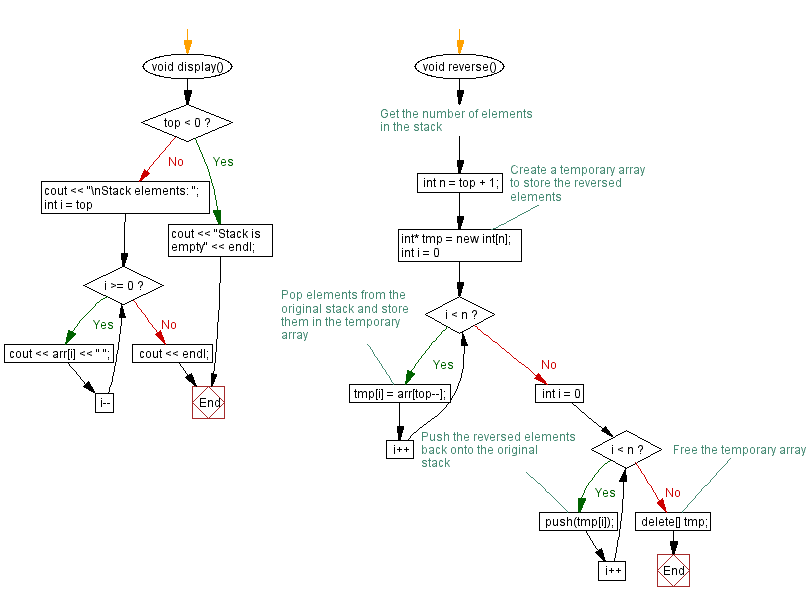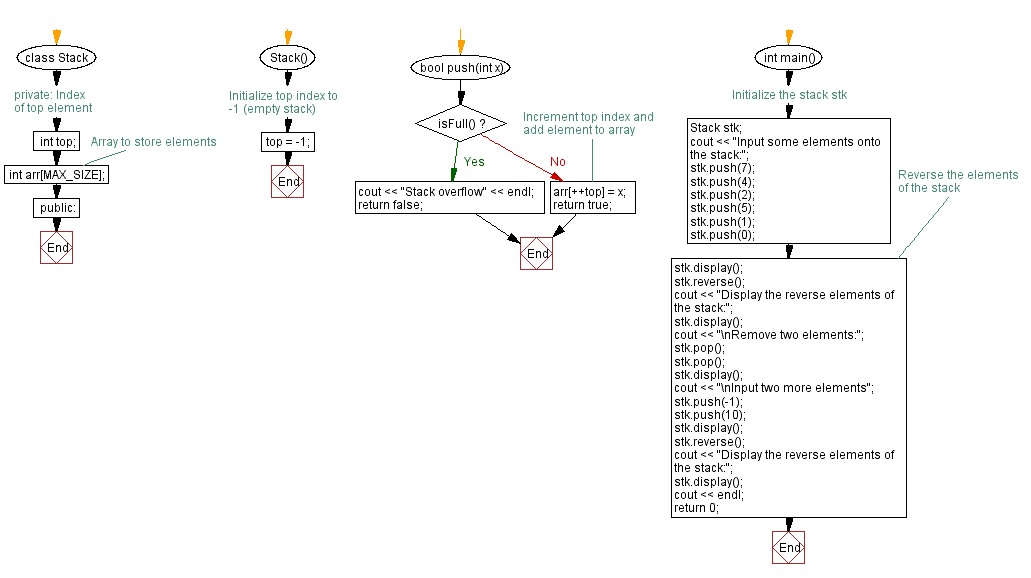C++ Stack Exercises: Reverse a stack (using an array) elements
4. Reverse the Stack Elements Using an Array
Write a C++ program that reverses the stack (using an array) elements.
Test Data:
Input some elements onto the stack:
Stack elements: 0 1 5 2 4 7
Display the reverse elements of the stack:
Stack elements: 7 4 2 5 1 0
Sample Solution:
C++ Code:
#include <iostream>
using namespace std;
#define MAX_SIZE 15 // Maximum size of stack
class Stack {
private:
int top; // Index of top element
int arr[MAX_SIZE]; // Array to store elements
public:
Stack() {
top = -1; // Initialize top index to -1 (empty stack)
}
bool push(int x) {
if (isFull()) {
cout << "Stack overflow" << endl; // Display message if stack is full
return false; // Return false to indicate failure in pushing element
}
// Increment top index and add element to array
arr[++top] = x;
return true; // Return true to indicate successful element addition
}
int pop() {
if (isEmpty()) {
cout << "Stack underflow" << endl; // Display message if stack is empty
return 0; // Return 0 to indicate failure in popping element
}
// Return top element and decrement top index
return arr[top--];
}
int peek() {
if (isEmpty()) {
cout << "Stack is empty" << endl; // Display message if stack is empty
return 0; // Return 0 to indicate failure in peeking element
}
// Return top element without modifying top index
return arr[top];
}
bool isEmpty() {
// Stack is empty if top index is -1
return (top < 0);
}
bool isFull() {
// Stack is full if top index is equal to MAX_SIZE - 1
return (top >= MAX_SIZE - 1);
}
void display() {
if (top < 0) {
cout << "Stack is empty" << endl; // Display message if stack is empty
return;
}
cout << "\nStack elements: ";
for (int i = top; i >= 0; i--)
cout << arr[i] << " "; // Display elements of the stack
cout << endl;
}
void reverse() {
int n = top + 1; // Get the number of elements in the stack
int* tmp = new int[n]; // Create a temporary array to store the reversed elements
for (int i = 0; i < n; i++) {
tmp[i] = arr[top--]; // Pop elements from the original stack and store them in the temporary array
}
for (int i = 0; i < n; i++) {
push(tmp[i]); // Push the reversed elements back onto the original stack
}
delete[] tmp; // Free the temporary array
}
};
int main() {
Stack stk; // Initialize the stack stk
cout << "Input some elements onto the stack:";
stk.push(7);
stk.push(4);
stk.push(2);
stk.push(5);
stk.push(1);
stk.push(0);
stk.display(); // Display the elements of the stack
cout << "\nReverse the elements in the stack:";
stk.reverse();
cout << "Display the reversed elements of the stack:";
stk.display(); // Display the reversed elements of the stack
cout << "\nRemove two elements:";
stk.pop();
stk.pop();
stk.display(); // Display elements of the stack after popping
cout << "\nInput two more elements";
stk.push(-1);
stk.push(10);
stk.display(); // Display elements of the stack after pushing
cout << "\nReverse the elements in the stack:";
stk.reverse();
cout << "Display the reversed elements of the stack:";
stk.display(); // Display the reversed elements of the stack after reversing again
cout << endl;
return 0;
}
Sample Output:
Input some elements onto the stack: Stack elements: 0 1 5 2 4 7 Display the reverse elements of the stack: Stack elements: 7 4 2 5 1 0 Remove two elements: Stack elements: 2 5 1 0 Input two more elements Stack elements: 10 -1 2 5 1 0 Display the reverse elements of the stack: Stack elements: 0 1 5 2 -1 10
Flowchart:



For more Practice: Solve these Related Problems:
- Write a C++ program to reverse an array-based stack by swapping elements from the top and bottom iteratively.
- Develop a C++ program that uses an array to implement a stack and then prints the stack elements in reverse order.
- Design a C++ program to reverse the contents of a stack (implemented with an array) using an in-place algorithm.
- Implement a C++ program to create a stack using an array and display its reverse without using extra memory for another array.
Go to:
PREV : Sort a Stack Using an Array and an Auxiliary Stack.
NEXT : Calculate the Average Value of Array-Based Stack Elements.
CPP Code Editor:
Contribute your code and comments through Disqus.
What is the difficulty level of this exercise?
